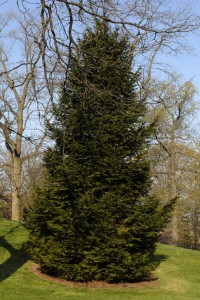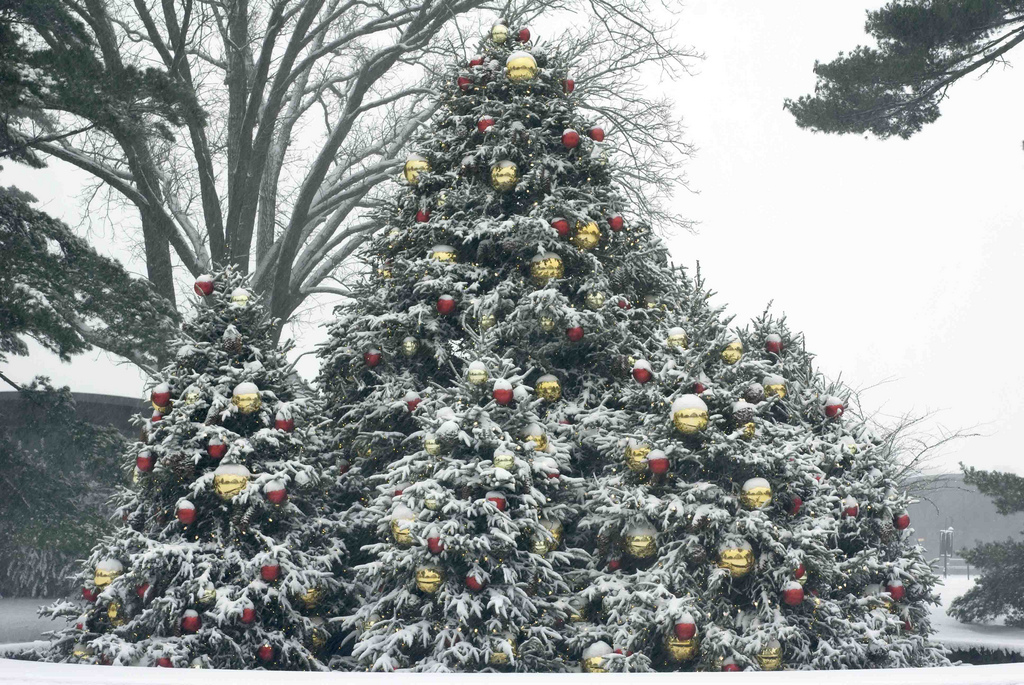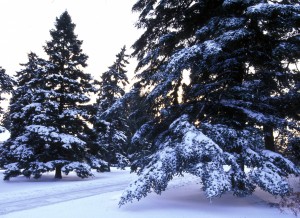A Christmas Conifer: Norway Spruce
Posted in Around the Garden, Gardens and Collections, What's Beautiful Now on December 21 2011, by Joyce Newman
Joyce H. Newman is the editor of Consumer Reports’ GreenerChoices.org, and has been a Garden Tour Guide with The New York Botanical Garden for the past six years.
 In front of our Visitor Center Café is an amazing specimen of Norway spruce (Picea abies), a species often known for its annual appearance as the Rockefeller Center Christmas Tree.
In front of our Visitor Center Café is an amazing specimen of Norway spruce (Picea abies), a species often known for its annual appearance as the Rockefeller Center Christmas Tree.
Our Norway spruce is part of the Arthur and Janet Ross Conifer Arboretum at the NYBG and was planted around 1940. Its medium to dark green needles are four-sided, resting on branches that gracefully droop down, designed to be flexible in a heavy snowfall.
Norway spruces can grow to as high as 90 or 100 feet, with a lifespan similar to that of a human being. They are native to the mountains and foothills of Northern Europe rather than the U.S., although they have become popular screening plants here. They grow just about one foot each year, which is considered fairly quick.
But Norway spruces aren’t the only kind of tree great for decorating. Several different conifer species are often holiday choices depending on local traditions. Among the best-selling trees are Scotch pine, Douglas fir, Noble fir, Fraser fir, Virginia pine, Balsam fir and White pine.
The NYBG’s own holiday tree at the reflecting pool is a 26-foot-tall Fraser fir from one of the oldest Christmas tree farms in the North Carolina mountains, near West Jefferson. Kurt Morrell–our Associate Vice President for Landscape Operations–visits this farm every year, hand-selecting the best tree for our display. It’s then brought by truck to the Garden in November and installed with a crane. After the holidays, the tree is recycled here to be turned into mulch and compost for many other plants at the Garden.

Other notable Christmas conifers include one inside the White House–a 19-foot Balsam fir from Wisconsin–as well as a Colorado spruce on the White House lawn.
According to the National Christmas Tree Association, an estimated 25-30 million farm-grown Christmas trees will be purchased in the United States this year. Most are grown by small farmers. However, they currently face a downward sales trend, with artificial trees taking over a larger share of the market.
Almost all real trees require shearing to attain the classic Christmas tree shape. It can take seven to ten years before a tree is mature and ready for cutting.
 The Rockefeller Center tree this year is a 74-foot Norway spruce that was cut down in a very small Pennsylvania town called Mifflinville. It was reported to be 75 years old. You can see a video of the tree being prepared for its trip here.
The Rockefeller Center tree this year is a 74-foot Norway spruce that was cut down in a very small Pennsylvania town called Mifflinville. It was reported to be 75 years old. You can see a video of the tree being prepared for its trip here.
Each year people from all around the country send in photos of their own trees, hoping that theirs will be selected to stand in Rockefeller Center. Once chosen, a police escort accompanies the tree on its overnight journey to its New York location. It arrives on a telescoping ‘stretch’ trailer, and requires a huge, hydraulic crane to be raised into position.
This year’s tree is decorated with 5 miles of energy-efficient LED lights. The lights will be on until January 7. After that, the Christmas tree will be turned into lumber for the housing charity Habitat for Humanity. In fact, most Christmas trees are recycled in various community recycling programs around the country.
Here at The New York Botanical Garden, we pay homage to Manhattan’s Norway spruce with our own Rockefeller Center in miniature, on display each year at our Holiday Train Show. Be sure to check it out for yourself!

